Arden University: IT Project Initiative Report on Virtual Reality Labs
VerifiedAdded on 2023/03/17
|25
|6660
|99
Report
AI Summary
This report examines Arden University's IT project initiative, which aims to integrate virtual reality (VR) into its distance learning programs to create immersive and interactive learning experiences. The initiative focuses on establishing a multi-user campus virtual environment to provide students with a realistic classroom setting, regardless of their geographical location. The report details the university's strategic plan, emphasizing partnerships, quality education, and continuous monitoring of student progress. It justifies the VR initiative's alignment with the university's objectives, highlighting cost-effectiveness and the development of vocationally advanced skills. Furthermore, the report explores IT staffing, including skill gap analysis and a comprehensive staffing policy plan, covering staff planning, training, acquisition, transition, and tracking to meet the project's needs. The report underscores the importance of data-driven decision-making and feedback mechanisms to enhance the overall learning experience and ensure the initiative's success.
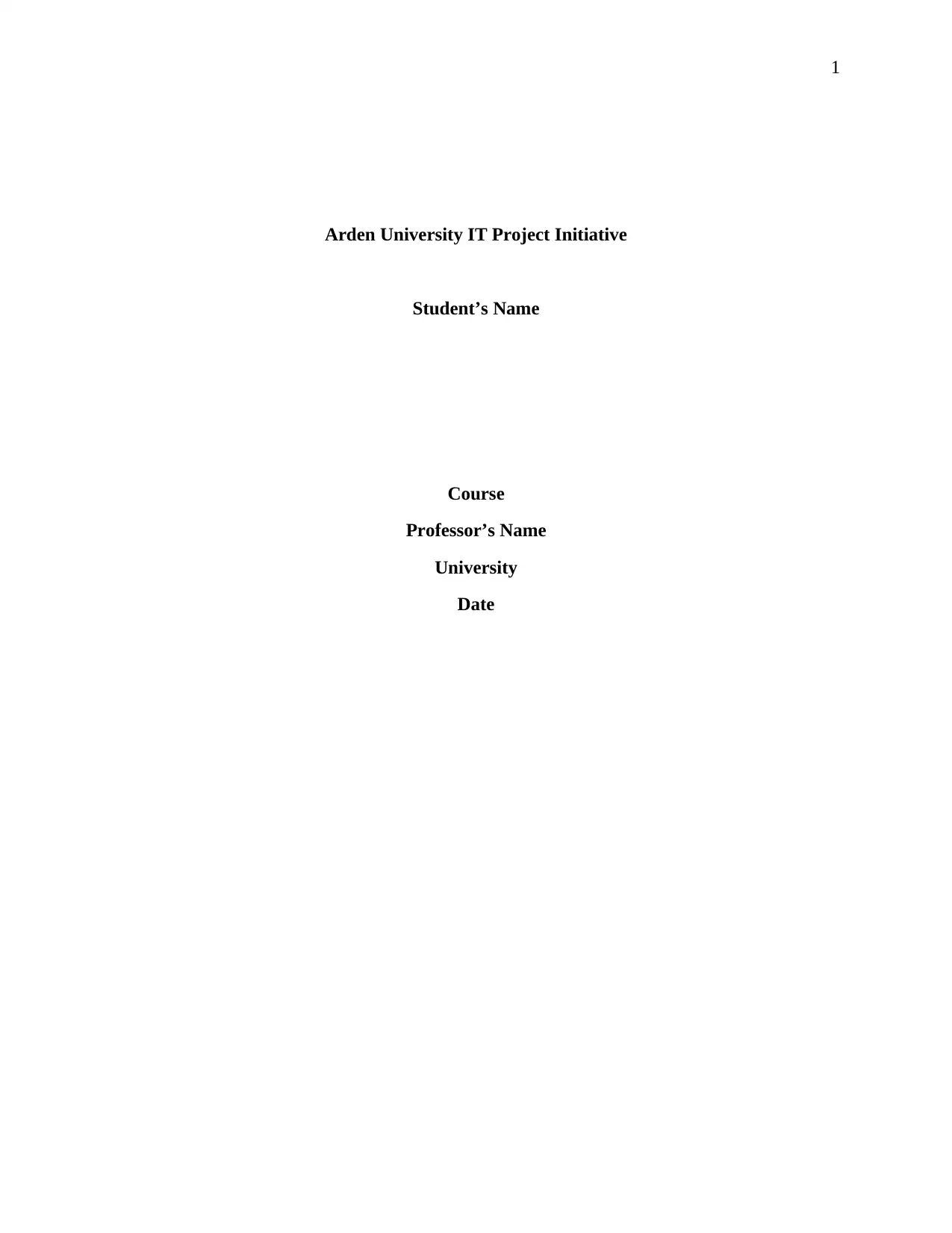
1
Arden University IT Project Initiative
Student’s Name
Course
Professor’s Name
University
Date
Arden University IT Project Initiative
Student’s Name
Course
Professor’s Name
University
Date
Paraphrase This Document
Need a fresh take? Get an instant paraphrase of this document with our AI Paraphraser
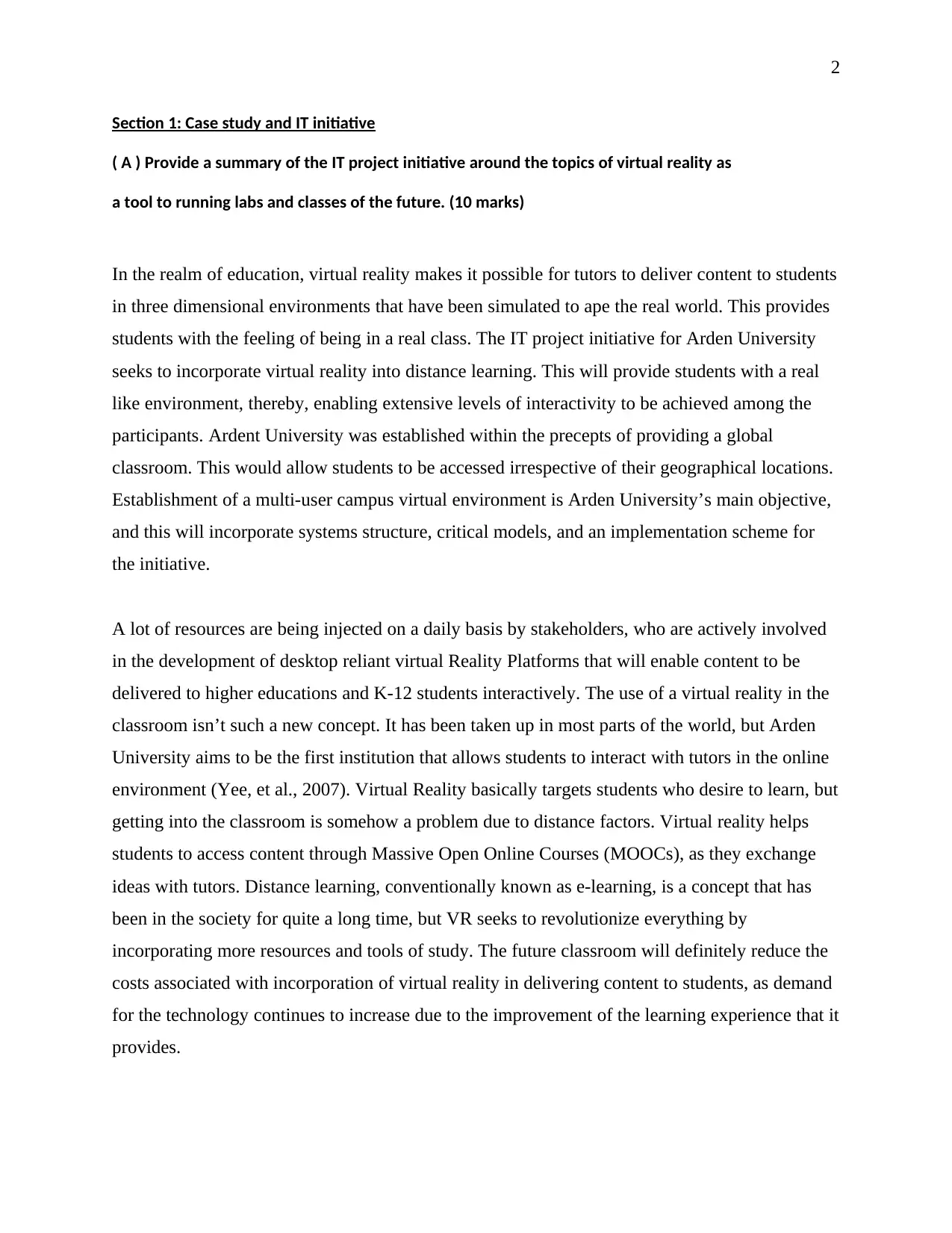
2
Section 1: Case study and IT initiative
( A ) Provide a summary of the IT project initiative around the topics of virtual reality as
a tool to running labs and classes of the future. (10 marks)
In the realm of education, virtual reality makes it possible for tutors to deliver content to students
in three dimensional environments that have been simulated to ape the real world. This provides
students with the feeling of being in a real class. The IT project initiative for Arden University
seeks to incorporate virtual reality into distance learning. This will provide students with a real
like environment, thereby, enabling extensive levels of interactivity to be achieved among the
participants. Ardent University was established within the precepts of providing a global
classroom. This would allow students to be accessed irrespective of their geographical locations.
Establishment of a multi-user campus virtual environment is Arden University’s main objective,
and this will incorporate systems structure, critical models, and an implementation scheme for
the initiative.
A lot of resources are being injected on a daily basis by stakeholders, who are actively involved
in the development of desktop reliant virtual Reality Platforms that will enable content to be
delivered to higher educations and K-12 students interactively. The use of a virtual reality in the
classroom isn’t such a new concept. It has been taken up in most parts of the world, but Arden
University aims to be the first institution that allows students to interact with tutors in the online
environment (Yee, et al., 2007). Virtual Reality basically targets students who desire to learn, but
getting into the classroom is somehow a problem due to distance factors. Virtual reality helps
students to access content through Massive Open Online Courses (MOOCs), as they exchange
ideas with tutors. Distance learning, conventionally known as e-learning, is a concept that has
been in the society for quite a long time, but VR seeks to revolutionize everything by
incorporating more resources and tools of study. The future classroom will definitely reduce the
costs associated with incorporation of virtual reality in delivering content to students, as demand
for the technology continues to increase due to the improvement of the learning experience that it
provides.
Section 1: Case study and IT initiative
( A ) Provide a summary of the IT project initiative around the topics of virtual reality as
a tool to running labs and classes of the future. (10 marks)
In the realm of education, virtual reality makes it possible for tutors to deliver content to students
in three dimensional environments that have been simulated to ape the real world. This provides
students with the feeling of being in a real class. The IT project initiative for Arden University
seeks to incorporate virtual reality into distance learning. This will provide students with a real
like environment, thereby, enabling extensive levels of interactivity to be achieved among the
participants. Ardent University was established within the precepts of providing a global
classroom. This would allow students to be accessed irrespective of their geographical locations.
Establishment of a multi-user campus virtual environment is Arden University’s main objective,
and this will incorporate systems structure, critical models, and an implementation scheme for
the initiative.
A lot of resources are being injected on a daily basis by stakeholders, who are actively involved
in the development of desktop reliant virtual Reality Platforms that will enable content to be
delivered to higher educations and K-12 students interactively. The use of a virtual reality in the
classroom isn’t such a new concept. It has been taken up in most parts of the world, but Arden
University aims to be the first institution that allows students to interact with tutors in the online
environment (Yee, et al., 2007). Virtual Reality basically targets students who desire to learn, but
getting into the classroom is somehow a problem due to distance factors. Virtual reality helps
students to access content through Massive Open Online Courses (MOOCs), as they exchange
ideas with tutors. Distance learning, conventionally known as e-learning, is a concept that has
been in the society for quite a long time, but VR seeks to revolutionize everything by
incorporating more resources and tools of study. The future classroom will definitely reduce the
costs associated with incorporation of virtual reality in delivering content to students, as demand
for the technology continues to increase due to the improvement of the learning experience that it
provides.
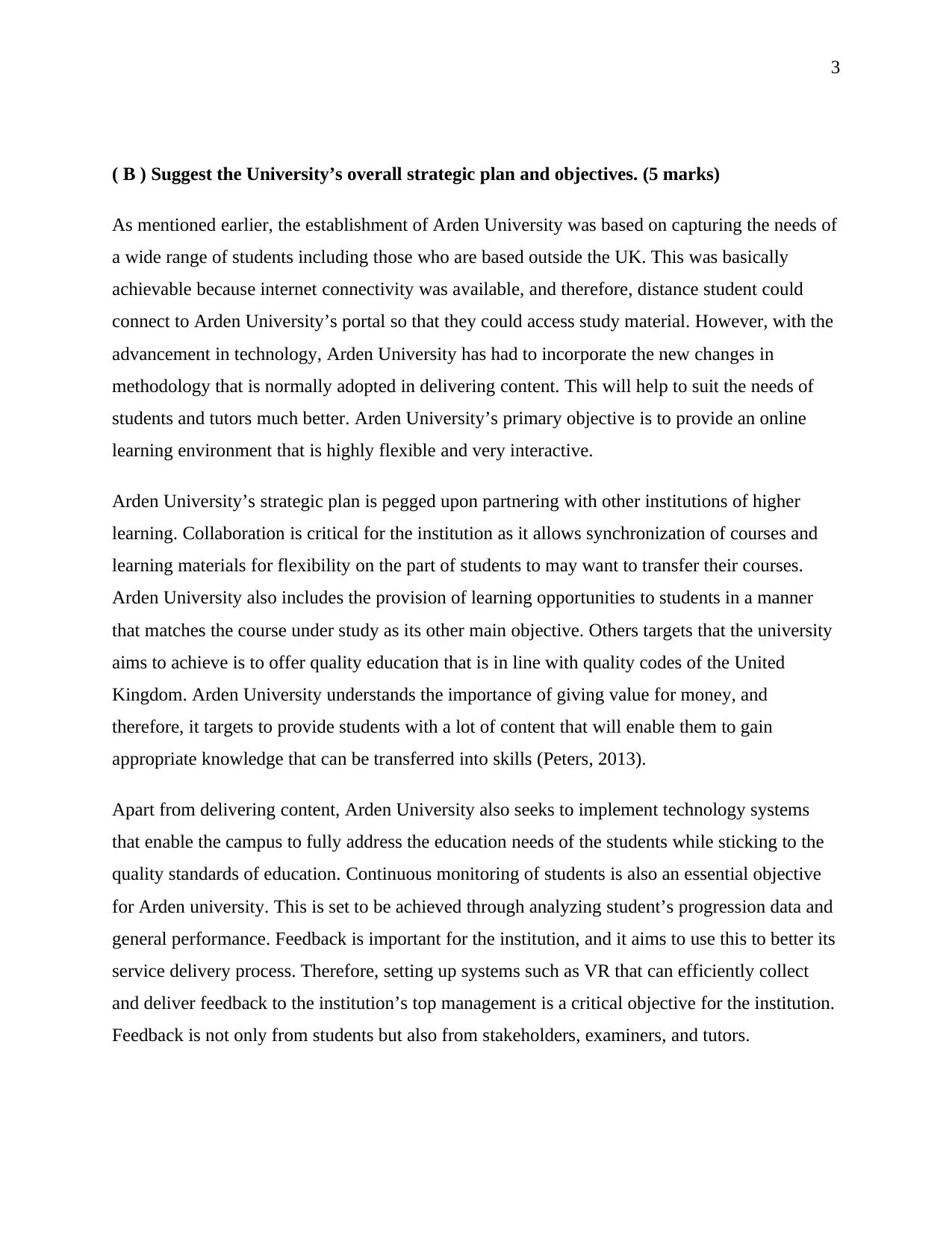
3
( B ) Suggest the University’s overall strategic plan and objectives. (5 marks)
As mentioned earlier, the establishment of Arden University was based on capturing the needs of
a wide range of students including those who are based outside the UK. This was basically
achievable because internet connectivity was available, and therefore, distance student could
connect to Arden University’s portal so that they could access study material. However, with the
advancement in technology, Arden University has had to incorporate the new changes in
methodology that is normally adopted in delivering content. This will help to suit the needs of
students and tutors much better. Arden University’s primary objective is to provide an online
learning environment that is highly flexible and very interactive.
Arden University’s strategic plan is pegged upon partnering with other institutions of higher
learning. Collaboration is critical for the institution as it allows synchronization of courses and
learning materials for flexibility on the part of students to may want to transfer their courses.
Arden University also includes the provision of learning opportunities to students in a manner
that matches the course under study as its other main objective. Others targets that the university
aims to achieve is to offer quality education that is in line with quality codes of the United
Kingdom. Arden University understands the importance of giving value for money, and
therefore, it targets to provide students with a lot of content that will enable them to gain
appropriate knowledge that can be transferred into skills (Peters, 2013).
Apart from delivering content, Arden University also seeks to implement technology systems
that enable the campus to fully address the education needs of the students while sticking to the
quality standards of education. Continuous monitoring of students is also an essential objective
for Arden university. This is set to be achieved through analyzing student’s progression data and
general performance. Feedback is important for the institution, and it aims to use this to better its
service delivery process. Therefore, setting up systems such as VR that can efficiently collect
and deliver feedback to the institution’s top management is a critical objective for the institution.
Feedback is not only from students but also from stakeholders, examiners, and tutors.
( B ) Suggest the University’s overall strategic plan and objectives. (5 marks)
As mentioned earlier, the establishment of Arden University was based on capturing the needs of
a wide range of students including those who are based outside the UK. This was basically
achievable because internet connectivity was available, and therefore, distance student could
connect to Arden University’s portal so that they could access study material. However, with the
advancement in technology, Arden University has had to incorporate the new changes in
methodology that is normally adopted in delivering content. This will help to suit the needs of
students and tutors much better. Arden University’s primary objective is to provide an online
learning environment that is highly flexible and very interactive.
Arden University’s strategic plan is pegged upon partnering with other institutions of higher
learning. Collaboration is critical for the institution as it allows synchronization of courses and
learning materials for flexibility on the part of students to may want to transfer their courses.
Arden University also includes the provision of learning opportunities to students in a manner
that matches the course under study as its other main objective. Others targets that the university
aims to achieve is to offer quality education that is in line with quality codes of the United
Kingdom. Arden University understands the importance of giving value for money, and
therefore, it targets to provide students with a lot of content that will enable them to gain
appropriate knowledge that can be transferred into skills (Peters, 2013).
Apart from delivering content, Arden University also seeks to implement technology systems
that enable the campus to fully address the education needs of the students while sticking to the
quality standards of education. Continuous monitoring of students is also an essential objective
for Arden university. This is set to be achieved through analyzing student’s progression data and
general performance. Feedback is important for the institution, and it aims to use this to better its
service delivery process. Therefore, setting up systems such as VR that can efficiently collect
and deliver feedback to the institution’s top management is a critical objective for the institution.
Feedback is not only from students but also from stakeholders, examiners, and tutors.
⊘ This is a preview!⊘
Do you want full access?
Subscribe today to unlock all pages.

Trusted by 1+ million students worldwide
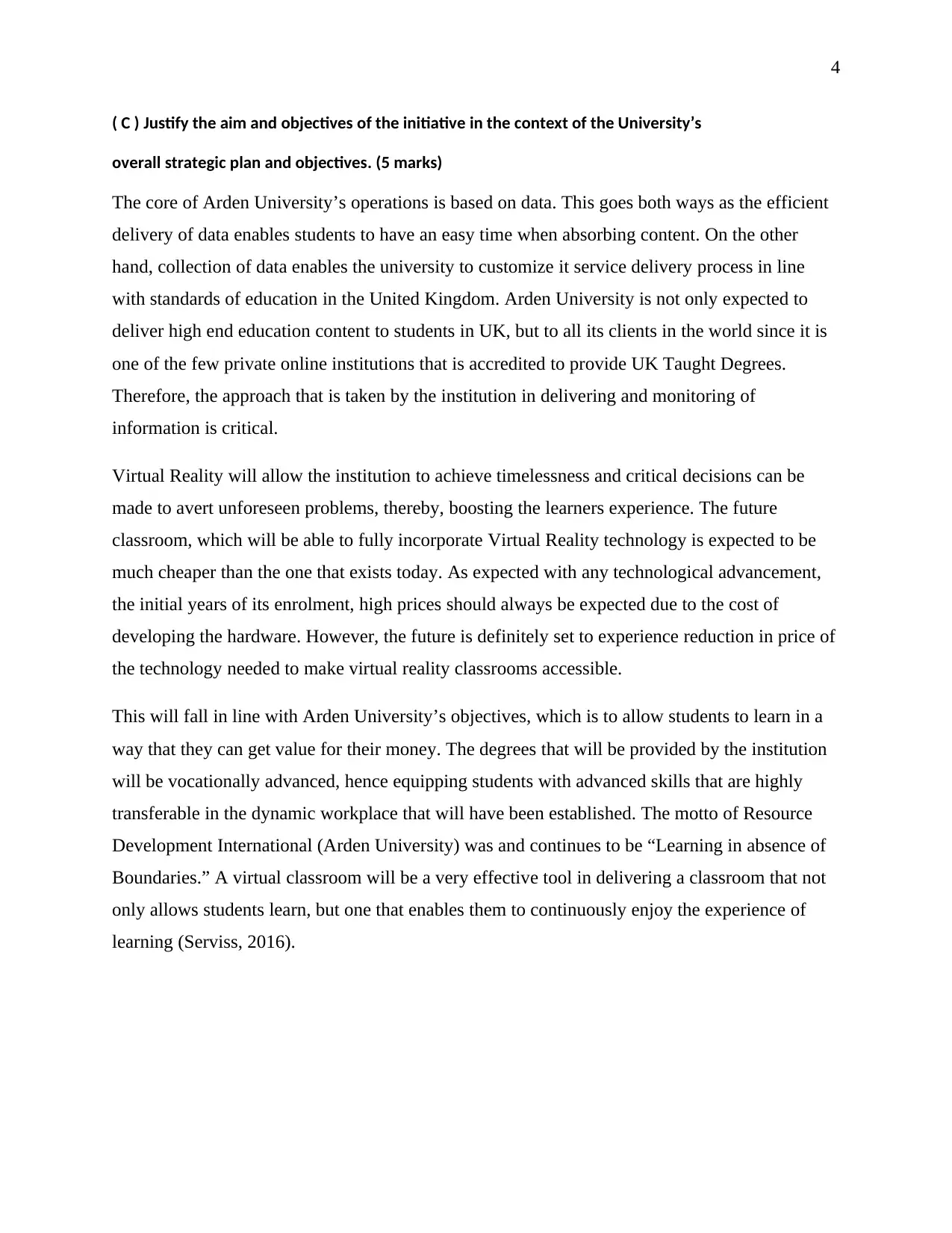
4
( C ) Justify the aim and objectives of the initiative in the context of the University’s
overall strategic plan and objectives. (5 marks)
The core of Arden University’s operations is based on data. This goes both ways as the efficient
delivery of data enables students to have an easy time when absorbing content. On the other
hand, collection of data enables the university to customize it service delivery process in line
with standards of education in the United Kingdom. Arden University is not only expected to
deliver high end education content to students in UK, but to all its clients in the world since it is
one of the few private online institutions that is accredited to provide UK Taught Degrees.
Therefore, the approach that is taken by the institution in delivering and monitoring of
information is critical.
Virtual Reality will allow the institution to achieve timelessness and critical decisions can be
made to avert unforeseen problems, thereby, boosting the learners experience. The future
classroom, which will be able to fully incorporate Virtual Reality technology is expected to be
much cheaper than the one that exists today. As expected with any technological advancement,
the initial years of its enrolment, high prices should always be expected due to the cost of
developing the hardware. However, the future is definitely set to experience reduction in price of
the technology needed to make virtual reality classrooms accessible.
This will fall in line with Arden University’s objectives, which is to allow students to learn in a
way that they can get value for their money. The degrees that will be provided by the institution
will be vocationally advanced, hence equipping students with advanced skills that are highly
transferable in the dynamic workplace that will have been established. The motto of Resource
Development International (Arden University) was and continues to be “Learning in absence of
Boundaries.” A virtual classroom will be a very effective tool in delivering a classroom that not
only allows students learn, but one that enables them to continuously enjoy the experience of
learning (Serviss, 2016).
( C ) Justify the aim and objectives of the initiative in the context of the University’s
overall strategic plan and objectives. (5 marks)
The core of Arden University’s operations is based on data. This goes both ways as the efficient
delivery of data enables students to have an easy time when absorbing content. On the other
hand, collection of data enables the university to customize it service delivery process in line
with standards of education in the United Kingdom. Arden University is not only expected to
deliver high end education content to students in UK, but to all its clients in the world since it is
one of the few private online institutions that is accredited to provide UK Taught Degrees.
Therefore, the approach that is taken by the institution in delivering and monitoring of
information is critical.
Virtual Reality will allow the institution to achieve timelessness and critical decisions can be
made to avert unforeseen problems, thereby, boosting the learners experience. The future
classroom, which will be able to fully incorporate Virtual Reality technology is expected to be
much cheaper than the one that exists today. As expected with any technological advancement,
the initial years of its enrolment, high prices should always be expected due to the cost of
developing the hardware. However, the future is definitely set to experience reduction in price of
the technology needed to make virtual reality classrooms accessible.
This will fall in line with Arden University’s objectives, which is to allow students to learn in a
way that they can get value for their money. The degrees that will be provided by the institution
will be vocationally advanced, hence equipping students with advanced skills that are highly
transferable in the dynamic workplace that will have been established. The motto of Resource
Development International (Arden University) was and continues to be “Learning in absence of
Boundaries.” A virtual classroom will be a very effective tool in delivering a classroom that not
only allows students learn, but one that enables them to continuously enjoy the experience of
learning (Serviss, 2016).
Paraphrase This Document
Need a fresh take? Get an instant paraphrase of this document with our AI Paraphraser
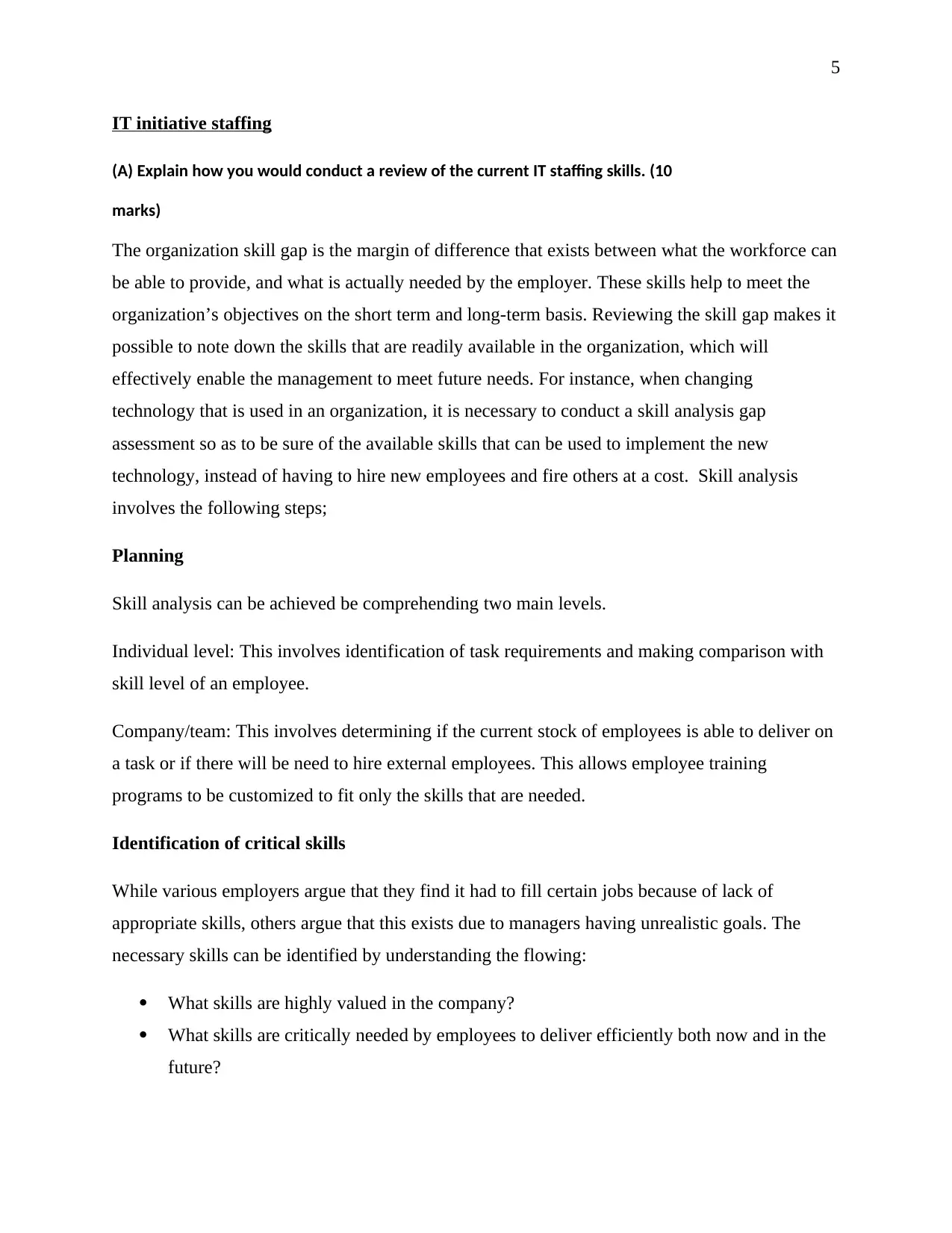
5
IT initiative staffing
(A) Explain how you would conduct a review of the current IT staffing skills. (10
marks)
The organization skill gap is the margin of difference that exists between what the workforce can
be able to provide, and what is actually needed by the employer. These skills help to meet the
organization’s objectives on the short term and long-term basis. Reviewing the skill gap makes it
possible to note down the skills that are readily available in the organization, which will
effectively enable the management to meet future needs. For instance, when changing
technology that is used in an organization, it is necessary to conduct a skill analysis gap
assessment so as to be sure of the available skills that can be used to implement the new
technology, instead of having to hire new employees and fire others at a cost. Skill analysis
involves the following steps;
Planning
Skill analysis can be achieved be comprehending two main levels.
Individual level: This involves identification of task requirements and making comparison with
skill level of an employee.
Company/team: This involves determining if the current stock of employees is able to deliver on
a task or if there will be need to hire external employees. This allows employee training
programs to be customized to fit only the skills that are needed.
Identification of critical skills
While various employers argue that they find it had to fill certain jobs because of lack of
appropriate skills, others argue that this exists due to managers having unrealistic goals. The
necessary skills can be identified by understanding the flowing:
What skills are highly valued in the company?
What skills are critically needed by employees to deliver efficiently both now and in the
future?
IT initiative staffing
(A) Explain how you would conduct a review of the current IT staffing skills. (10
marks)
The organization skill gap is the margin of difference that exists between what the workforce can
be able to provide, and what is actually needed by the employer. These skills help to meet the
organization’s objectives on the short term and long-term basis. Reviewing the skill gap makes it
possible to note down the skills that are readily available in the organization, which will
effectively enable the management to meet future needs. For instance, when changing
technology that is used in an organization, it is necessary to conduct a skill analysis gap
assessment so as to be sure of the available skills that can be used to implement the new
technology, instead of having to hire new employees and fire others at a cost. Skill analysis
involves the following steps;
Planning
Skill analysis can be achieved be comprehending two main levels.
Individual level: This involves identification of task requirements and making comparison with
skill level of an employee.
Company/team: This involves determining if the current stock of employees is able to deliver on
a task or if there will be need to hire external employees. This allows employee training
programs to be customized to fit only the skills that are needed.
Identification of critical skills
While various employers argue that they find it had to fill certain jobs because of lack of
appropriate skills, others argue that this exists due to managers having unrealistic goals. The
necessary skills can be identified by understanding the flowing:
What skills are highly valued in the company?
What skills are critically needed by employees to deliver efficiently both now and in the
future?
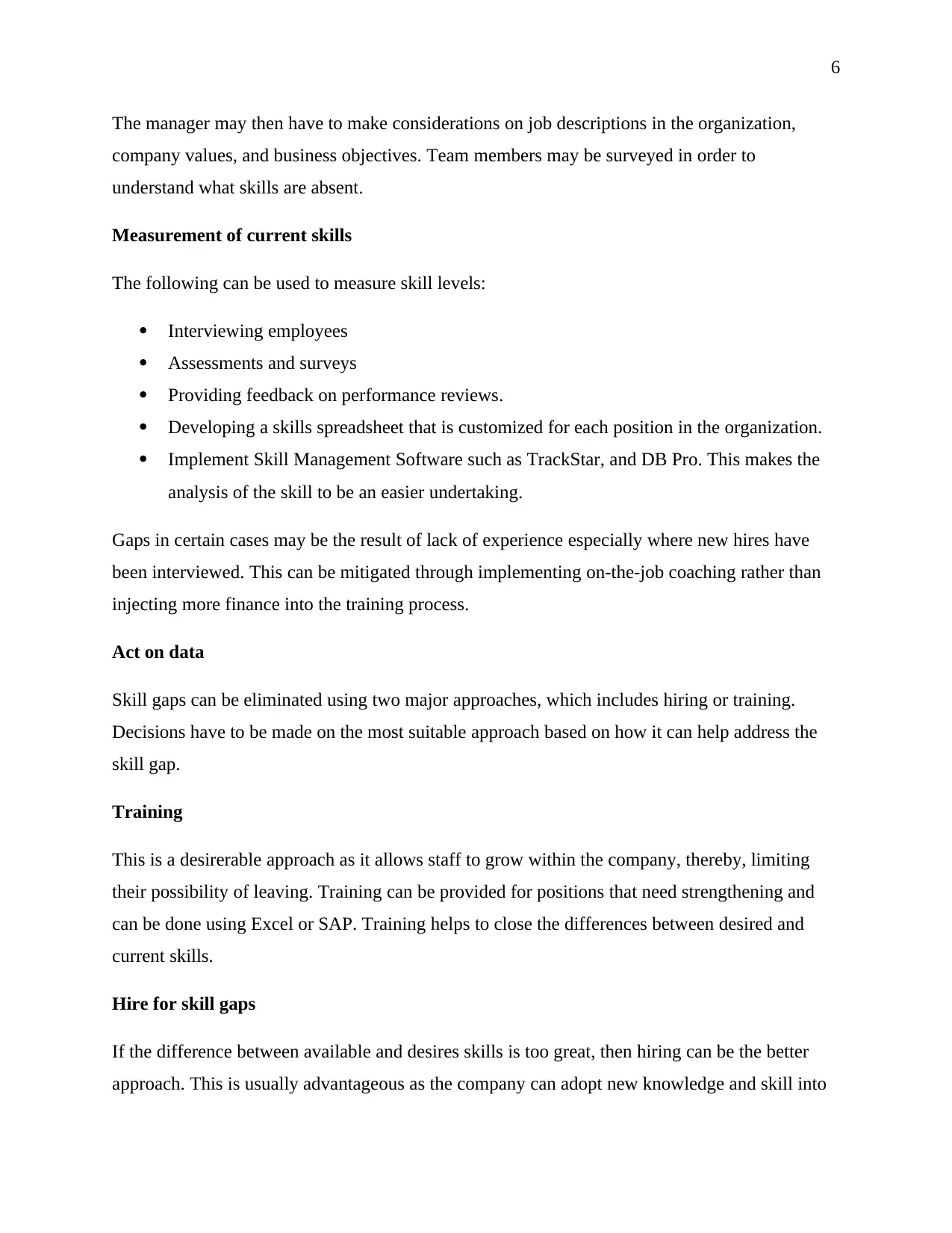
6
The manager may then have to make considerations on job descriptions in the organization,
company values, and business objectives. Team members may be surveyed in order to
understand what skills are absent.
Measurement of current skills
The following can be used to measure skill levels:
Interviewing employees
Assessments and surveys
Providing feedback on performance reviews.
Developing a skills spreadsheet that is customized for each position in the organization.
Implement Skill Management Software such as TrackStar, and DB Pro. This makes the
analysis of the skill to be an easier undertaking.
Gaps in certain cases may be the result of lack of experience especially where new hires have
been interviewed. This can be mitigated through implementing on-the-job coaching rather than
injecting more finance into the training process.
Act on data
Skill gaps can be eliminated using two major approaches, which includes hiring or training.
Decisions have to be made on the most suitable approach based on how it can help address the
skill gap.
Training
This is a desirerable approach as it allows staff to grow within the company, thereby, limiting
their possibility of leaving. Training can be provided for positions that need strengthening and
can be done using Excel or SAP. Training helps to close the differences between desired and
current skills.
Hire for skill gaps
If the difference between available and desires skills is too great, then hiring can be the better
approach. This is usually advantageous as the company can adopt new knowledge and skill into
The manager may then have to make considerations on job descriptions in the organization,
company values, and business objectives. Team members may be surveyed in order to
understand what skills are absent.
Measurement of current skills
The following can be used to measure skill levels:
Interviewing employees
Assessments and surveys
Providing feedback on performance reviews.
Developing a skills spreadsheet that is customized for each position in the organization.
Implement Skill Management Software such as TrackStar, and DB Pro. This makes the
analysis of the skill to be an easier undertaking.
Gaps in certain cases may be the result of lack of experience especially where new hires have
been interviewed. This can be mitigated through implementing on-the-job coaching rather than
injecting more finance into the training process.
Act on data
Skill gaps can be eliminated using two major approaches, which includes hiring or training.
Decisions have to be made on the most suitable approach based on how it can help address the
skill gap.
Training
This is a desirerable approach as it allows staff to grow within the company, thereby, limiting
their possibility of leaving. Training can be provided for positions that need strengthening and
can be done using Excel or SAP. Training helps to close the differences between desired and
current skills.
Hire for skill gaps
If the difference between available and desires skills is too great, then hiring can be the better
approach. This is usually advantageous as the company can adopt new knowledge and skill into
⊘ This is a preview!⊘
Do you want full access?
Subscribe today to unlock all pages.

Trusted by 1+ million students worldwide
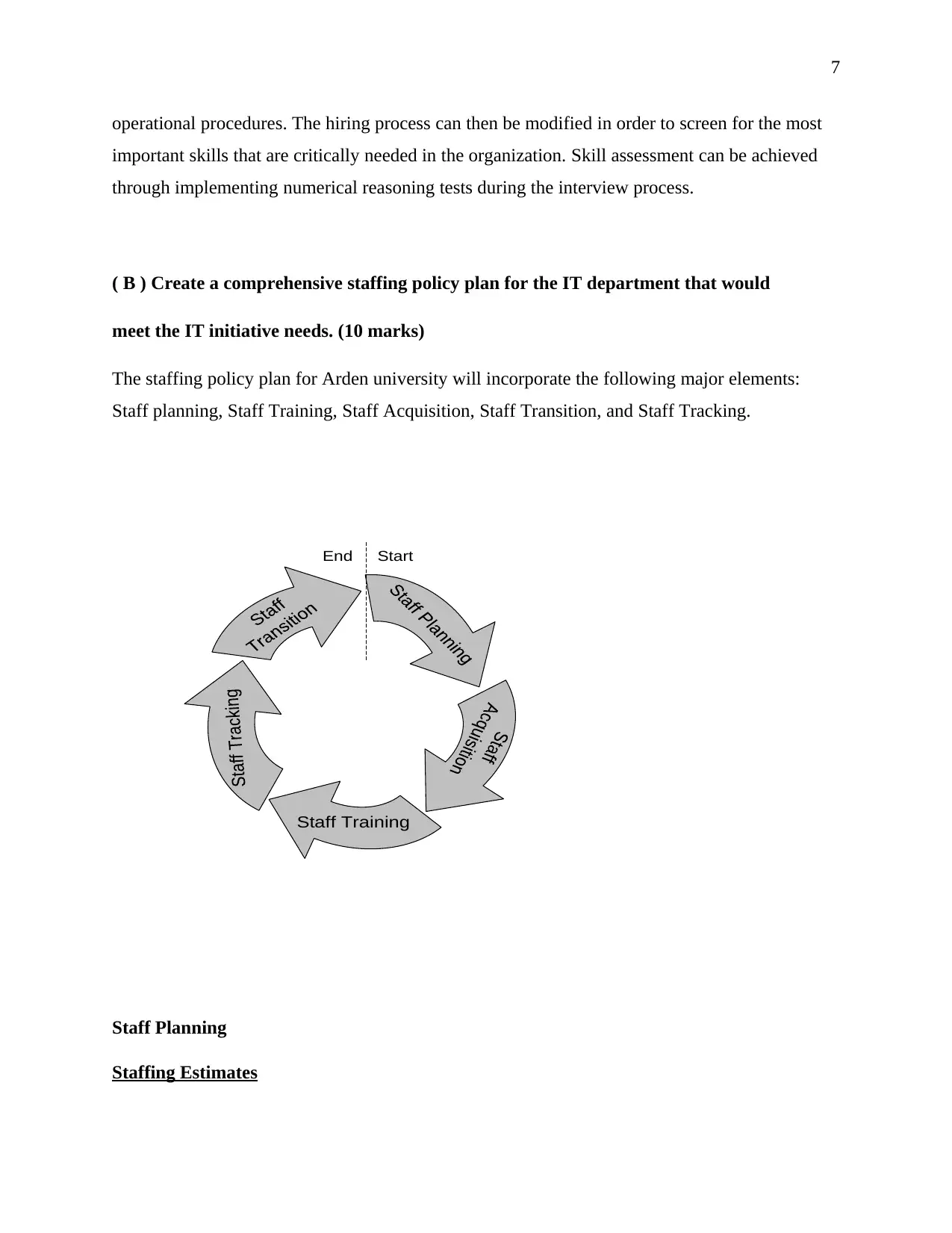
7
operational procedures. The hiring process can then be modified in order to screen for the most
important skills that are critically needed in the organization. Skill assessment can be achieved
through implementing numerical reasoning tests during the interview process.
( B ) Create a comprehensive staffing policy plan for the IT department that would
meet the IT initiative needs. (10 marks)
The staffing policy plan for Arden university will incorporate the following major elements:
Staff planning, Staff Training, Staff Acquisition, Staff Transition, and Staff Tracking.
Staff Planning
Staffing Estimates
Staff Training
StartEnd
operational procedures. The hiring process can then be modified in order to screen for the most
important skills that are critically needed in the organization. Skill assessment can be achieved
through implementing numerical reasoning tests during the interview process.
( B ) Create a comprehensive staffing policy plan for the IT department that would
meet the IT initiative needs. (10 marks)
The staffing policy plan for Arden university will incorporate the following major elements:
Staff planning, Staff Training, Staff Acquisition, Staff Transition, and Staff Tracking.
Staff Planning
Staffing Estimates
Staff Training
StartEnd
Paraphrase This Document
Need a fresh take? Get an instant paraphrase of this document with our AI Paraphraser
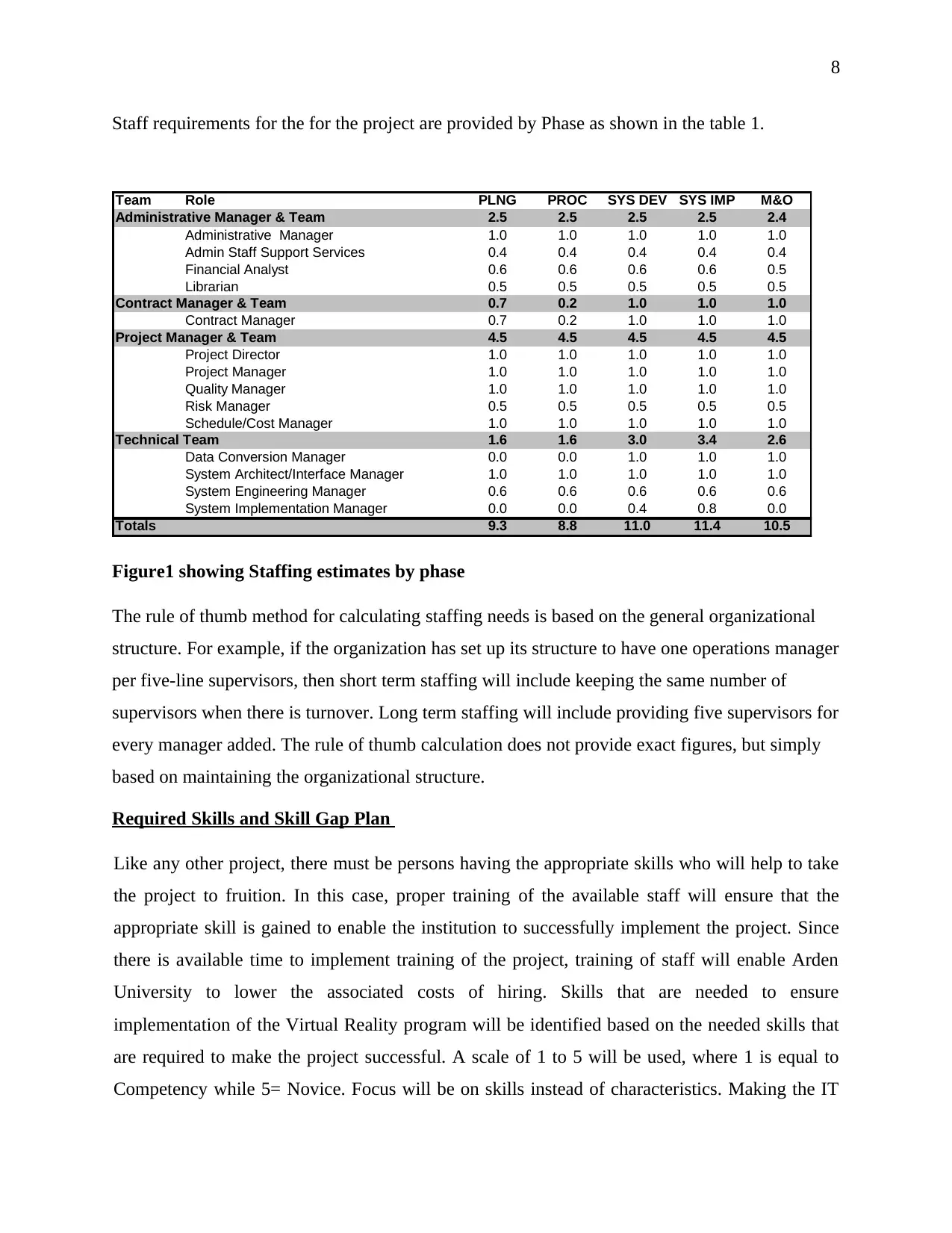
8
Staff requirements for the for the project are provided by Phase as shown in the table 1.
Figure1 showing Staffing estimates by phase
The rule of thumb method for calculating staffing needs is based on the general organizational
structure. For example, if the organization has set up its structure to have one operations manager
per five-line supervisors, then short term staffing will include keeping the same number of
supervisors when there is turnover. Long term staffing will include providing five supervisors for
every manager added. The rule of thumb calculation does not provide exact figures, but simply
based on maintaining the organizational structure.
Required Skills and Skill Gap Plan
Like any other project, there must be persons having the appropriate skills who will help to take
the project to fruition. In this case, proper training of the available staff will ensure that the
appropriate skill is gained to enable the institution to successfully implement the project. Since
there is available time to implement training of the project, training of staff will enable Arden
University to lower the associated costs of hiring. Skills that are needed to ensure
implementation of the Virtual Reality program will be identified based on the needed skills that
are required to make the project successful. A scale of 1 to 5 will be used, where 1 is equal to
Competency while 5= Novice. Focus will be on skills instead of characteristics. Making the IT
Team Role PLNG PROC SYS DEV SYS IMP M&O
Administrative Manager & Team 2.5 2.5 2.5 2.5 2.4
Administrative Manager 1.0 1.0 1.0 1.0 1.0
Admin Staff Support Services 0.4 0.4 0.4 0.4 0.4
Financial Analyst 0.6 0.6 0.6 0.6 0.5
Librarian 0.5 0.5 0.5 0.5 0.5
Contract Manager & Team 0.7 0.2 1.0 1.0 1.0
Contract Manager 0.7 0.2 1.0 1.0 1.0
Project Manager & Team 4.5 4.5 4.5 4.5 4.5
Project Director 1.0 1.0 1.0 1.0 1.0
Project Manager 1.0 1.0 1.0 1.0 1.0
Quality Manager 1.0 1.0 1.0 1.0 1.0
Risk Manager 0.5 0.5 0.5 0.5 0.5
Schedule/Cost Manager 1.0 1.0 1.0 1.0 1.0
Technical Team 1.6 1.6 3.0 3.4 2.6
Data Conversion Manager 0.0 0.0 1.0 1.0 1.0
System Architect/Interface Manager 1.0 1.0 1.0 1.0 1.0
System Engineering Manager 0.6 0.6 0.6 0.6 0.6
System Implementation Manager 0.0 0.0 0.4 0.8 0.0
Totals 9.3 8.8 11.0 11.4 10.5
Staff requirements for the for the project are provided by Phase as shown in the table 1.
Figure1 showing Staffing estimates by phase
The rule of thumb method for calculating staffing needs is based on the general organizational
structure. For example, if the organization has set up its structure to have one operations manager
per five-line supervisors, then short term staffing will include keeping the same number of
supervisors when there is turnover. Long term staffing will include providing five supervisors for
every manager added. The rule of thumb calculation does not provide exact figures, but simply
based on maintaining the organizational structure.
Required Skills and Skill Gap Plan
Like any other project, there must be persons having the appropriate skills who will help to take
the project to fruition. In this case, proper training of the available staff will ensure that the
appropriate skill is gained to enable the institution to successfully implement the project. Since
there is available time to implement training of the project, training of staff will enable Arden
University to lower the associated costs of hiring. Skills that are needed to ensure
implementation of the Virtual Reality program will be identified based on the needed skills that
are required to make the project successful. A scale of 1 to 5 will be used, where 1 is equal to
Competency while 5= Novice. Focus will be on skills instead of characteristics. Making the IT
Team Role PLNG PROC SYS DEV SYS IMP M&O
Administrative Manager & Team 2.5 2.5 2.5 2.5 2.4
Administrative Manager 1.0 1.0 1.0 1.0 1.0
Admin Staff Support Services 0.4 0.4 0.4 0.4 0.4
Financial Analyst 0.6 0.6 0.6 0.6 0.5
Librarian 0.5 0.5 0.5 0.5 0.5
Contract Manager & Team 0.7 0.2 1.0 1.0 1.0
Contract Manager 0.7 0.2 1.0 1.0 1.0
Project Manager & Team 4.5 4.5 4.5 4.5 4.5
Project Director 1.0 1.0 1.0 1.0 1.0
Project Manager 1.0 1.0 1.0 1.0 1.0
Quality Manager 1.0 1.0 1.0 1.0 1.0
Risk Manager 0.5 0.5 0.5 0.5 0.5
Schedule/Cost Manager 1.0 1.0 1.0 1.0 1.0
Technical Team 1.6 1.6 3.0 3.4 2.6
Data Conversion Manager 0.0 0.0 1.0 1.0 1.0
System Architect/Interface Manager 1.0 1.0 1.0 1.0 1.0
System Engineering Manager 0.6 0.6 0.6 0.6 0.6
System Implementation Manager 0.0 0.0 0.4 0.8 0.0
Totals 9.3 8.8 11.0 11.4 10.5
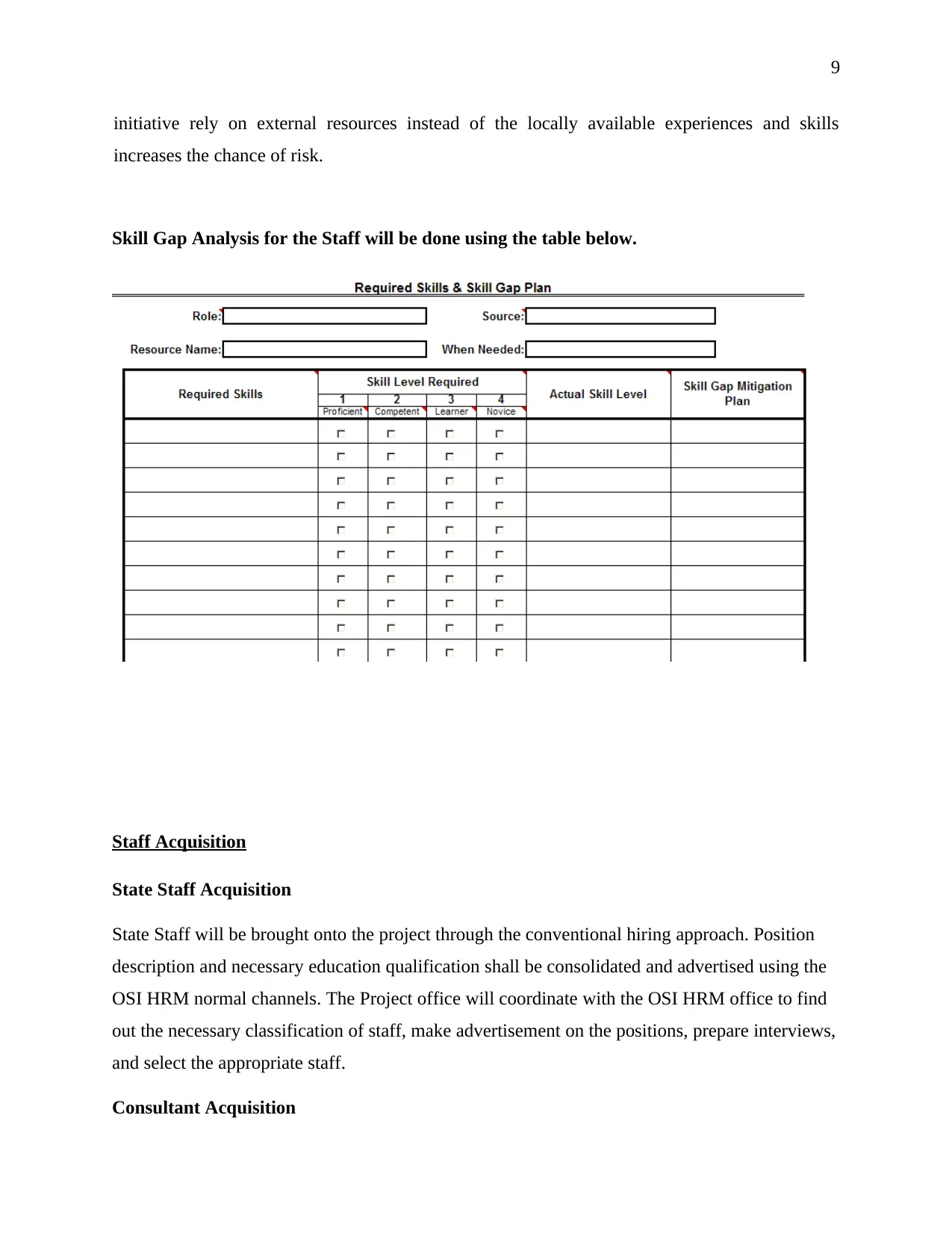
9
initiative rely on external resources instead of the locally available experiences and skills
increases the chance of risk.
Skill Gap Analysis for the Staff will be done using the table below.
Staff Acquisition
State Staff Acquisition
State Staff will be brought onto the project through the conventional hiring approach. Position
description and necessary education qualification shall be consolidated and advertised using the
OSI HRM normal channels. The Project office will coordinate with the OSI HRM office to find
out the necessary classification of staff, make advertisement on the positions, prepare interviews,
and select the appropriate staff.
Consultant Acquisition
initiative rely on external resources instead of the locally available experiences and skills
increases the chance of risk.
Skill Gap Analysis for the Staff will be done using the table below.
Staff Acquisition
State Staff Acquisition
State Staff will be brought onto the project through the conventional hiring approach. Position
description and necessary education qualification shall be consolidated and advertised using the
OSI HRM normal channels. The Project office will coordinate with the OSI HRM office to find
out the necessary classification of staff, make advertisement on the positions, prepare interviews,
and select the appropriate staff.
Consultant Acquisition
⊘ This is a preview!⊘
Do you want full access?
Subscribe today to unlock all pages.

Trusted by 1+ million students worldwide
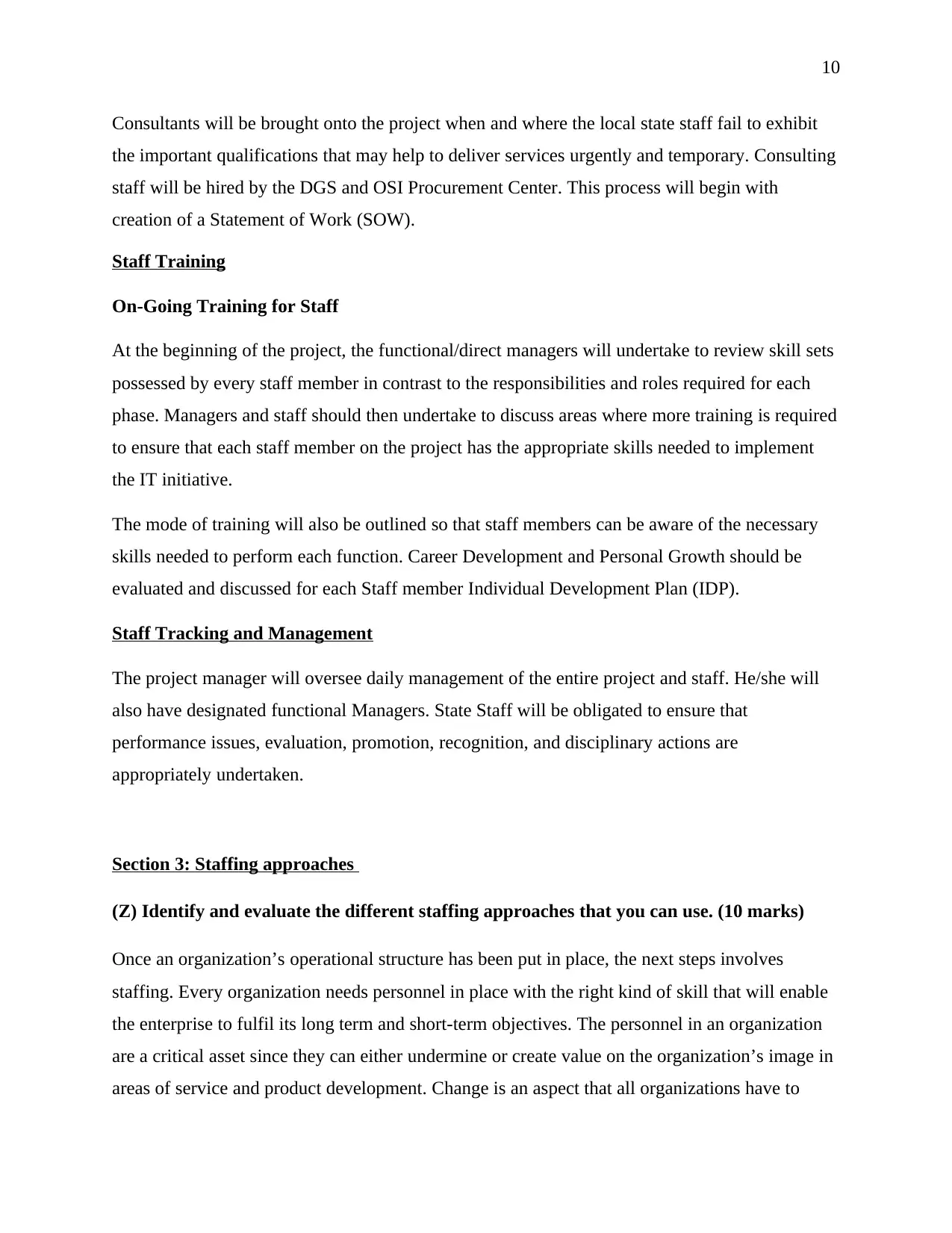
10
Consultants will be brought onto the project when and where the local state staff fail to exhibit
the important qualifications that may help to deliver services urgently and temporary. Consulting
staff will be hired by the DGS and OSI Procurement Center. This process will begin with
creation of a Statement of Work (SOW).
Staff Training
On-Going Training for Staff
At the beginning of the project, the functional/direct managers will undertake to review skill sets
possessed by every staff member in contrast to the responsibilities and roles required for each
phase. Managers and staff should then undertake to discuss areas where more training is required
to ensure that each staff member on the project has the appropriate skills needed to implement
the IT initiative.
The mode of training will also be outlined so that staff members can be aware of the necessary
skills needed to perform each function. Career Development and Personal Growth should be
evaluated and discussed for each Staff member Individual Development Plan (IDP).
Staff Tracking and Management
The project manager will oversee daily management of the entire project and staff. He/she will
also have designated functional Managers. State Staff will be obligated to ensure that
performance issues, evaluation, promotion, recognition, and disciplinary actions are
appropriately undertaken.
Section 3: Staffing approaches
(Z) Identify and evaluate the different staffing approaches that you can use. (10 marks)
Once an organization’s operational structure has been put in place, the next steps involves
staffing. Every organization needs personnel in place with the right kind of skill that will enable
the enterprise to fulfil its long term and short-term objectives. The personnel in an organization
are a critical asset since they can either undermine or create value on the organization’s image in
areas of service and product development. Change is an aspect that all organizations have to
Consultants will be brought onto the project when and where the local state staff fail to exhibit
the important qualifications that may help to deliver services urgently and temporary. Consulting
staff will be hired by the DGS and OSI Procurement Center. This process will begin with
creation of a Statement of Work (SOW).
Staff Training
On-Going Training for Staff
At the beginning of the project, the functional/direct managers will undertake to review skill sets
possessed by every staff member in contrast to the responsibilities and roles required for each
phase. Managers and staff should then undertake to discuss areas where more training is required
to ensure that each staff member on the project has the appropriate skills needed to implement
the IT initiative.
The mode of training will also be outlined so that staff members can be aware of the necessary
skills needed to perform each function. Career Development and Personal Growth should be
evaluated and discussed for each Staff member Individual Development Plan (IDP).
Staff Tracking and Management
The project manager will oversee daily management of the entire project and staff. He/she will
also have designated functional Managers. State Staff will be obligated to ensure that
performance issues, evaluation, promotion, recognition, and disciplinary actions are
appropriately undertaken.
Section 3: Staffing approaches
(Z) Identify and evaluate the different staffing approaches that you can use. (10 marks)
Once an organization’s operational structure has been put in place, the next steps involves
staffing. Every organization needs personnel in place with the right kind of skill that will enable
the enterprise to fulfil its long term and short-term objectives. The personnel in an organization
are a critical asset since they can either undermine or create value on the organization’s image in
areas of service and product development. Change is an aspect that all organizations have to
Paraphrase This Document
Need a fresh take? Get an instant paraphrase of this document with our AI Paraphraser
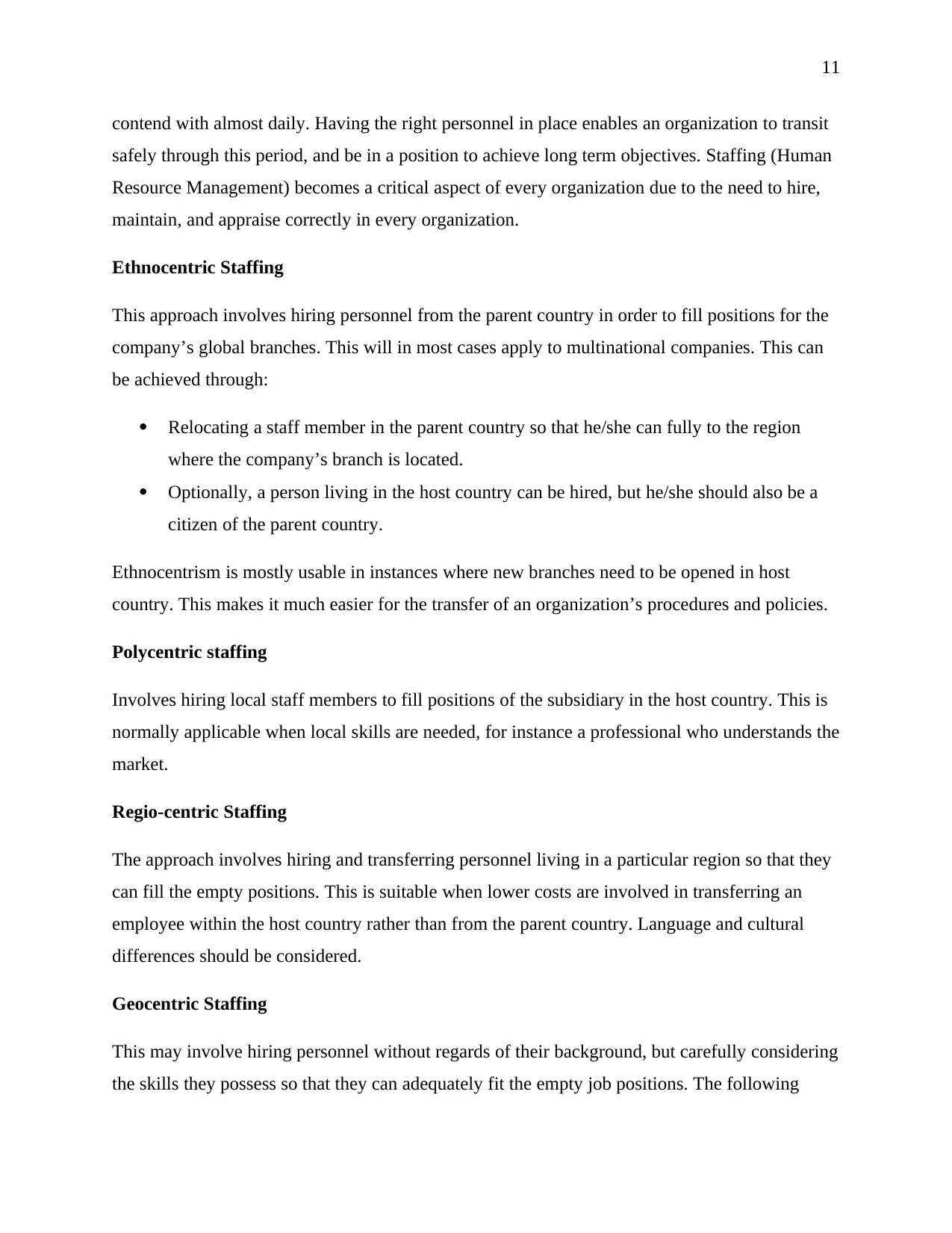
11
contend with almost daily. Having the right personnel in place enables an organization to transit
safely through this period, and be in a position to achieve long term objectives. Staffing (Human
Resource Management) becomes a critical aspect of every organization due to the need to hire,
maintain, and appraise correctly in every organization.
Ethnocentric Staffing
This approach involves hiring personnel from the parent country in order to fill positions for the
company’s global branches. This will in most cases apply to multinational companies. This can
be achieved through:
Relocating a staff member in the parent country so that he/she can fully to the region
where the company’s branch is located.
Optionally, a person living in the host country can be hired, but he/she should also be a
citizen of the parent country.
Ethnocentrism is mostly usable in instances where new branches need to be opened in host
country. This makes it much easier for the transfer of an organization’s procedures and policies.
Polycentric staffing
Involves hiring local staff members to fill positions of the subsidiary in the host country. This is
normally applicable when local skills are needed, for instance a professional who understands the
market.
Regio-centric Staffing
The approach involves hiring and transferring personnel living in a particular region so that they
can fill the empty positions. This is suitable when lower costs are involved in transferring an
employee within the host country rather than from the parent country. Language and cultural
differences should be considered.
Geocentric Staffing
This may involve hiring personnel without regards of their background, but carefully considering
the skills they possess so that they can adequately fit the empty job positions. The following
contend with almost daily. Having the right personnel in place enables an organization to transit
safely through this period, and be in a position to achieve long term objectives. Staffing (Human
Resource Management) becomes a critical aspect of every organization due to the need to hire,
maintain, and appraise correctly in every organization.
Ethnocentric Staffing
This approach involves hiring personnel from the parent country in order to fill positions for the
company’s global branches. This will in most cases apply to multinational companies. This can
be achieved through:
Relocating a staff member in the parent country so that he/she can fully to the region
where the company’s branch is located.
Optionally, a person living in the host country can be hired, but he/she should also be a
citizen of the parent country.
Ethnocentrism is mostly usable in instances where new branches need to be opened in host
country. This makes it much easier for the transfer of an organization’s procedures and policies.
Polycentric staffing
Involves hiring local staff members to fill positions of the subsidiary in the host country. This is
normally applicable when local skills are needed, for instance a professional who understands the
market.
Regio-centric Staffing
The approach involves hiring and transferring personnel living in a particular region so that they
can fill the empty positions. This is suitable when lower costs are involved in transferring an
employee within the host country rather than from the parent country. Language and cultural
differences should be considered.
Geocentric Staffing
This may involve hiring personnel without regards of their background, but carefully considering
the skills they possess so that they can adequately fit the empty job positions. The following
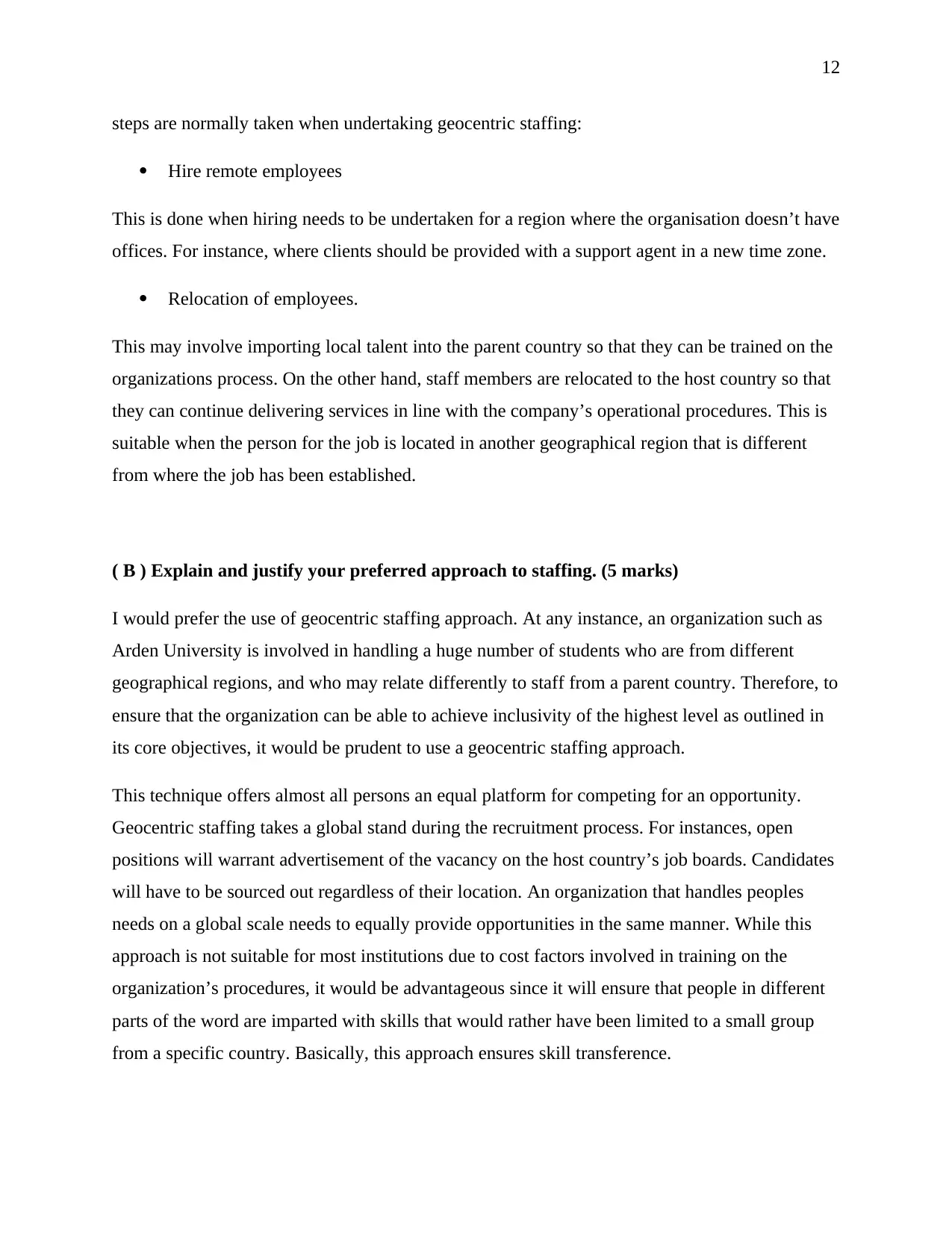
12
steps are normally taken when undertaking geocentric staffing:
Hire remote employees
This is done when hiring needs to be undertaken for a region where the organisation doesn’t have
offices. For instance, where clients should be provided with a support agent in a new time zone.
Relocation of employees.
This may involve importing local talent into the parent country so that they can be trained on the
organizations process. On the other hand, staff members are relocated to the host country so that
they can continue delivering services in line with the company’s operational procedures. This is
suitable when the person for the job is located in another geographical region that is different
from where the job has been established.
( B ) Explain and justify your preferred approach to staffing. (5 marks)
I would prefer the use of geocentric staffing approach. At any instance, an organization such as
Arden University is involved in handling a huge number of students who are from different
geographical regions, and who may relate differently to staff from a parent country. Therefore, to
ensure that the organization can be able to achieve inclusivity of the highest level as outlined in
its core objectives, it would be prudent to use a geocentric staffing approach.
This technique offers almost all persons an equal platform for competing for an opportunity.
Geocentric staffing takes a global stand during the recruitment process. For instances, open
positions will warrant advertisement of the vacancy on the host country’s job boards. Candidates
will have to be sourced out regardless of their location. An organization that handles peoples
needs on a global scale needs to equally provide opportunities in the same manner. While this
approach is not suitable for most institutions due to cost factors involved in training on the
organization’s procedures, it would be advantageous since it will ensure that people in different
parts of the word are imparted with skills that would rather have been limited to a small group
from a specific country. Basically, this approach ensures skill transference.
steps are normally taken when undertaking geocentric staffing:
Hire remote employees
This is done when hiring needs to be undertaken for a region where the organisation doesn’t have
offices. For instance, where clients should be provided with a support agent in a new time zone.
Relocation of employees.
This may involve importing local talent into the parent country so that they can be trained on the
organizations process. On the other hand, staff members are relocated to the host country so that
they can continue delivering services in line with the company’s operational procedures. This is
suitable when the person for the job is located in another geographical region that is different
from where the job has been established.
( B ) Explain and justify your preferred approach to staffing. (5 marks)
I would prefer the use of geocentric staffing approach. At any instance, an organization such as
Arden University is involved in handling a huge number of students who are from different
geographical regions, and who may relate differently to staff from a parent country. Therefore, to
ensure that the organization can be able to achieve inclusivity of the highest level as outlined in
its core objectives, it would be prudent to use a geocentric staffing approach.
This technique offers almost all persons an equal platform for competing for an opportunity.
Geocentric staffing takes a global stand during the recruitment process. For instances, open
positions will warrant advertisement of the vacancy on the host country’s job boards. Candidates
will have to be sourced out regardless of their location. An organization that handles peoples
needs on a global scale needs to equally provide opportunities in the same manner. While this
approach is not suitable for most institutions due to cost factors involved in training on the
organization’s procedures, it would be advantageous since it will ensure that people in different
parts of the word are imparted with skills that would rather have been limited to a small group
from a specific country. Basically, this approach ensures skill transference.
⊘ This is a preview!⊘
Do you want full access?
Subscribe today to unlock all pages.

Trusted by 1+ million students worldwide
1 out of 25
Related Documents
Your All-in-One AI-Powered Toolkit for Academic Success.
+13062052269
info@desklib.com
Available 24*7 on WhatsApp / Email
![[object Object]](/_next/static/media/star-bottom.7253800d.svg)
Unlock your academic potential
Copyright © 2020–2025 A2Z Services. All Rights Reserved. Developed and managed by ZUCOL.





